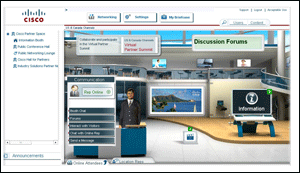BtoB Marketers Moving Towards Virtual Events As Budgets Tighten & ROI Scrutiny Heats Up
- Published in Feature Articles
With travel budgets getting squeezed and marketing investments under ROI microscope, many of the largest BtoB organizations are migrating toward virtual event platforms. As an example, industry insiders report that one of the top enterprise software providers recently mandated the company’s physical event spend be reduced by 20% in 2008 and 50% in 2009. At the same time, high tech heavyweights such as Cisco and Quest Software have successfully shifted partner events over to the virtual world, and have reported positive ROI and lead generation metrics.
 In early 2008, Cisco was looking for a unique online environment that would allow its global partner network to virtually interact, collaborate and learn. The company engaged Unisfair to create a virtual space where Cisco resellers, distributors and solution providers could exchange leads and business opportunities, build geographic and technology practices and access the latest tools and information.
In early 2008, Cisco was looking for a unique online environment that would allow its global partner network to virtually interact, collaborate and learn. The company engaged Unisfair to create a virtual space where Cisco resellers, distributors and solution providers could exchange leads and business opportunities, build geographic and technology practices and access the latest tools and information.
The Cisco Virtual Partner Summit featured 25 different webcasts on the enablement, industry solutions and training. Utilizing Web 2.0 tools to enable real-time and around the clock collaboration, 52 countries represented in over 100 booths were able to communicate and engage.
Of the initial 1,800 initial attendees on the day of the launch, 71 percent have since returned numerous times. On average, each booth has been visited 30 times with over 3,500 tracked from Cisco’s Partner Locator search. Nearly 600 attendees have created profiles with nearly 500 developing group profiles that showcase their experience and needs.
One Unisfair client reported great success with their first ever virtual event. In addition to a $23 cost-per-inquiry rate and attendee analytics, the average attendee stayed for over an hour to learn and explore.
Despite the rapid growth of virtual events, Don Best, director of marketing at Unisfair, a leader in the virtual event space. Best says virtual events are not replacing physical events, but are emerging more as an additional tool in the marketing mix. And while a lot of the early adopters have been enterprise level accounts, Best suggests the technology is now scalable enough to fit small to midsized firms.
Best suggests marketers focus on the following three key features/benefits when migrating to a new virtual event:
 In early 2008, Cisco was looking for a unique online environment that would allow its global partner network to virtually interact, collaborate and learn. The company engaged Unisfair to create a virtual space where Cisco resellers, distributors and solution providers could exchange leads and business opportunities, build geographic and technology practices and access the latest tools and information.
In early 2008, Cisco was looking for a unique online environment that would allow its global partner network to virtually interact, collaborate and learn. The company engaged Unisfair to create a virtual space where Cisco resellers, distributors and solution providers could exchange leads and business opportunities, build geographic and technology practices and access the latest tools and information. The Cisco Virtual Partner Summit featured 25 different webcasts on the enablement, industry solutions and training. Utilizing Web 2.0 tools to enable real-time and around the clock collaboration, 52 countries represented in over 100 booths were able to communicate and engage.
Of the initial 1,800 initial attendees on the day of the launch, 71 percent have since returned numerous times. On average, each booth has been visited 30 times with over 3,500 tracked from Cisco’s Partner Locator search. Nearly 600 attendees have created profiles with nearly 500 developing group profiles that showcase their experience and needs.
One Unisfair client reported great success with their first ever virtual event. In addition to a $23 cost-per-inquiry rate and attendee analytics, the average attendee stayed for over an hour to learn and explore.
Despite the rapid growth of virtual events, Don Best, director of marketing at Unisfair, a leader in the virtual event space. Best says virtual events are not replacing physical events, but are emerging more as an additional tool in the marketing mix. And while a lot of the early adopters have been enterprise level accounts, Best suggests the technology is now scalable enough to fit small to midsized firms.
Best suggests marketers focus on the following three key features/benefits when migrating to a new virtual event:
- Education/Knowledge Transfer- Virtual events offer an incredible wealth of information. Attendees can access rich media, all types of information on a company, all from the convenience of their desktop. On-demand features enable attendees to access information at their leisure.
- Networking- Communication is important, and the live interaction between attendees and live presenters and booth reps is easy and convenient. While physical events have simultaneous sessions, virtual events enable attendees to explore content on demand—avoiding scheduling constraints or overlap with another session.
- Accessibility- “You might be able to get 100-200 people to a physical event, while some virtual event hosts deal in the thousands, extending tenfold and expanding the event globally,” Best says. He adds that marketers can also in a wealth of information about attendee’s behavior during the event. They know every session they attended and what questions they asked, if they downloaded any information associating a presentation. Unisfair has a tool to set criteria to rank all attendees according from hottest to coldest leads based on behavioral information.

